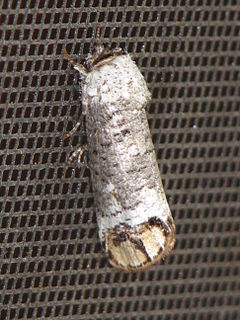
A pupa is the life stage of some insects undergoing transformation between immature and mature stages. The pupal stage is found only in holometabolous insects, those that undergo a complete metamorphosis, with four life stages: egg, larva, pupa, and imago. The processes of entering and completing the pupal stage are controlled by the insect's hormones, especially juvenile hormone, prothoracicotropic hormone, and ecdysone. The act of becoming a pupa is called pupation, and the act of emerging from the pupal case is called eclosion or emergence.

The Tortricidae are a family of moths, commonly known as tortrix moths or leafroller moths, in the order Lepidoptera. This large family has over 10,350 species described, and is the sole member of the superfamily Tortricoidea, although the genus Heliocosma is sometimes placed within this superfamily. Many of these are economically important pests. Olethreutidae is a junior synonym. The typical resting posture is with the wings folded back, producing a rather rounded profile.

The Gelechiidae are a family of moths commonly referred to as twirler moths or gelechiid moths. They are the namesake family of the huge and little-studied superfamily Gelechioidea, and the family's taxonomy has been subject to considerable dispute. These are generally very small moths with narrow, fringed wings. The larvae of most species feed internally on various parts of their host plants, sometimes causing galls. Douglas-fir (Pseudotsuga) is a host plant common to many species of the family, particularly of the genus Chionodes, which as a result is more diverse in North America than usual for Gelechioidea.

The Pyralidae, commonly called pyralid moths, snout moths or grass moths, are a family of Lepidoptera in the ditrysian superfamily Pyraloidea. In many classifications, the grass moths (Crambidae) are included in the Pyralidae as a subfamily, making the combined group one of the largest families in the Lepidoptera. The latest review by Eugene G. Munroe and Maria Alma Solis, in Kristensen (1999) retains the Crambidae as a full family of Pyraloidea.

The Cossidae, the cossid millers or carpenter millers, make up a family of mostly large miller moths. This family contains over 110 genera with almost 700 known species, and many more species await description. Carpenter millers are nocturnal Lepidoptera found worldwide, except the Southeast Asian subfamily Ratardinae, which is mostly active during the day.
Doidae is a family of Lepidoptera first described by Julian P. Donahue and John W. Brown in 1987. It is sometimes treated as a subfamily of the Notodontidae. Species have been placed in the Arctiidae, Lymantriidae and the Dioptidae.

The Phaegopterina are a subtribe of tiger moths in the tribe Arctiini, which is part of the family Erebidae. The subtribe was described by William Forsell Kirby in 1892.
Epimolis is a genus of moths in the family Erebidae. The genus was erected by Harrison Gray Dyar Jr. in 1913.
Zatrephes is a genus of moths in the family Erebidae. The genus was erected by Jacob Hübner in 1819. It was formerly considered part of the Arctiidae. It includes the former genus Ennomomima, which is now considered a synonym.

The Erebidae are a family of moths in the superfamily Noctuoidea. The family is among the largest families of moths by species count and contains a wide variety of well-known macromoth groups. The family includes the underwings (Catocala); litter moths (Herminiinae); tiger, lichen, and wasp moths (Arctiinae); tussock moths (Lymantriinae), including the arctic woolly bear moth ; piercing moths ; micronoctuoid moths (Micronoctuini); snout moths (Hypeninae); and zales, though many of these common names can also refer to moths outside the Erebidae. Some of the erebid moths are called owlets.
Epimolis creon is a moth of the family Erebidae. It was described by Herbert Druce in 1897. It is found in Mexico.
Epimolis affinis is a moth of the family Erebidae. It was described by Walter Rothschild in 1909. It is found in French Guiana, Venezuela and Peru.
Epimolis conifera is a moth of the family Erebidae. It was described by Paul Dognin in 1912. It is found in Colombia.
Epimolis flavonotata is a moth of the family Erebidae. It was described by Walter Rothschild in 1909. It is found in French Guiana, the Amazon region and Venezuela.
Epimolis haemastica is a moth of the family Erebidae. It was described by Paul Dognin in 1906. It is found in Peru and Colombia.

Epimolis incarnata is a moth of the family Erebidae. It was described by George Hampson in 1901. It is found in French Guiana, Brazil, Ecuador and Peru.

Pseudepimolis incisa is a moth of the family Erebidae. It was described by Walter Rothschild in 1909. It is found in Costa Rica, French Guiana, Brazil, the upper Amazon region, Venezuela and Bolivia.
Epimolis pseudopraemolis is a moth of the family Erebidae. It was described by Walter Rothschild in 1909. It is found in Peru.
Epimolis syrissa is a moth of the family Erebidae. It was described by Herbert Druce in 1906. It is found in Peru.








